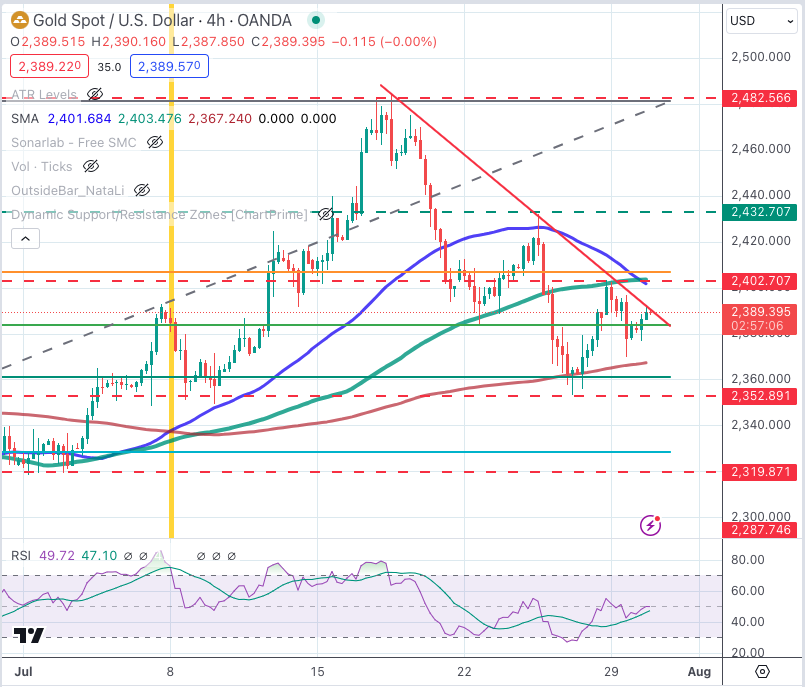- Gold appreciates with risk appetite returning as geopolitical fears ease..
- Hopes that the Fed might hint towards monetary easing on Wednesday keep US Treasury yields near mid-term lows.
- XAU/USD needs to break the $2,400 resistance to cancel the broader bearish structure.
Gold price (XAU/USD) found buyers after a moderate pullback on Monday. The precious metal has been going through a mild recovery during Tuesday’s Asian session that has continued in the European morning.
News reporting that Israel is willing to avoid an all-out war in the Middle East has eased geopolitical concerns, allowing the safe-haven US Dollar (USD) to trim some gains.
Investors’ focus is now on the Federal Reserve’s (Fed) monetary policy decision, due on Wednesday. The bank will highly likely leave interest rates unchanged, but the attention will be on the ensuing press release by Fed Chair Jerome Powell. With price pressures on a disinflationary trend and the labour market finally showing signs of exhaustion, Powell might suggest that the easing cycle might start before December. That would harm the US Dollar and support precious metals.
Daily digest market movers: Gold picks up within recent range with all eyes on the Fed
- Gold is regaining some of the ground lost on Monday, favoured by a somewhat brighter market mood as concerns of a full-blown war in the Middle East have eased.
- Israeli authorities assured that they want to retaliate Hizbullah, for the rocket attack that killed 12 people on the weekend, but that they want to avoid a regional war in the Middle East. This has calmed market fears.
- Later today, the Conference Board is expected to show that the Consumer Sentiment Index deteriorated marginally in July, to a reading of 99.5 from the 100.4 posted in the previous month.
- In the same line, US JOLTS Job Openings are seen to have declined to 8.03 million in June from the 8.14 million openings reported in May.
- The Fed is releasing its monetary policy decision on Wednesday, and the recent inflation readings have boosted market expectations that the bank might signal the exit of the restrictive cycle.
- US 10-year yields are marginally above four-month highs, while the 2-year yield, the most closely related to interest rate expectations, remains depressed at their lowest levels since February.
- The CME Group’s Fed Watch tool is pricing a 95% chance that the Fed will keep rates on hold on Wednesday and a 100% chance that rate cuts will start in September.
Technical analysis: XAU/USD remains capped below the $2,400 resistance level
XAU/USD is on a corrective decline after having been capped right below the $2,500 level in mid-July. The pair has found significant support at the 61.8% Fibonacci retracement of the June-July bullish run, near $2,360, and the higher low printed last week suggests that the correction might have been completed.
The 4-hour Relative Strength Index (RSI) indicator is pulling higher and about to cross the key 50 level. The precious metal, however, might need an extra boost to breach the 2,400 resistance area. Soft data today and a dovish Fed would probably do it. The next target, in this case, would be $2,430.
On the downside, supports are at the mentioned 61.8% Fibonacci retracement, at $2,350, ahead of $2,320.
XAU/USD 4-hour chart

Central banks FAQs
Central Banks have a key mandate which is making sure that there is price stability in a country or region. Economies are constantly facing inflation or deflation when prices for certain goods and services are fluctuating. Constant rising prices for the same goods means inflation, constant lowered prices for the same goods means deflation. It is the task of the central bank to keep the demand in line by tweaking its policy rate. For the biggest central banks like the US Federal Reserve (Fed), the European Central Bank (ECB) or the Bank of England (BoE), the mandate is to keep inflation close to 2%.
A central bank has one important tool at its disposal to get inflation higher or lower, and that is by tweaking its benchmark policy rate, commonly known as interest rate. On pre-communicated moments, the central bank will issue a statement with its policy rate and provide additional reasoning on why it is either remaining or changing (cutting or hiking) it. Local banks will adjust their savings and lending rates accordingly, which in turn will make it either harder or easier for people to earn on their savings or for companies to take out loans and make investments in their businesses. When the central bank hikes interest rates substantially, this is called monetary tightening. When it is cutting its benchmark rate, it is called monetary easing.
A central bank is often politically independent. Members of the central bank policy board are passing through a series of panels and hearings before being appointed to a policy board seat. Each member in that board often has a certain conviction on how the central bank should control inflation and the subsequent monetary policy. Members that want a very loose monetary policy, with low rates and cheap lending, to boost the economy substantially while being content to see inflation slightly above 2%, are called ‘doves’. Members that rather want to see higher rates to reward savings and want to keep a lit on inflation at all time are called ‘hawks’ and will not rest until inflation is at or just below 2%.
Normally, there is a chairman or president who leads each meeting, needs to create a consensus between the hawks or doves and has his or her final say when it would come down to a vote split to avoid a 50-50 tie on whether the current policy should be adjusted. The chairman will deliver speeches which often can be followed live, where the current monetary stance and outlook is being communicated. A central bank will try to push forward its monetary policy without triggering violent swings in rates, equities, or its currency. All members of the central bank will channel their stance toward the markets in advance of a policy meeting event. A few days before a policy meeting takes place until the new policy has been communicated, members are forbidden to talk publicly. This is called the blackout period.
